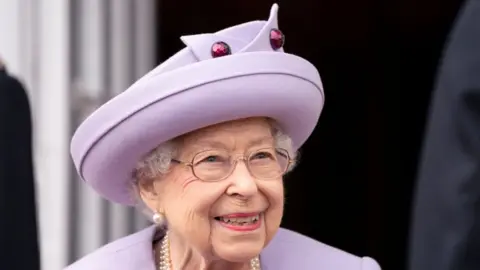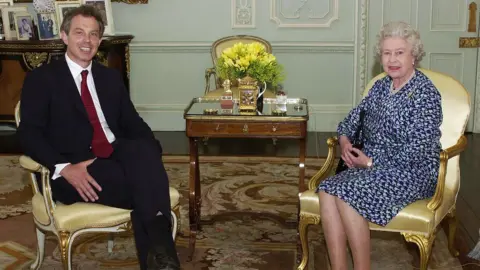Queen to appoint new prime minister at Balmoral
 Getty Images
Getty ImagesThe Queen will not appoint the next prime minister in London, but will instead stay in Balmoral to do it, Buckingham Palace has said.
The new PM and Boris Johnson will go to Scotland, in a break from tradition for the event on 6 September.
During her 70-year-reign the Queen, 96, has had an audience with her new prime minister at Buckingham Palace.
It is understood that the decision was taken to provide certainty for the new prime minister's diary.
The Queen has suffered from mobility issues and it is understood the change was made to prevent the need for any last-minute rearrangements.
Liz Truss or Rishi Sunak will be announced as leader of the Conservative Party on Monday 5 September.
Boris Johnson is expected to announce his resignation to the Queen the following day, with his successor appointed by the monarch shortly after.
Buckingham Palace previously said the Queen would interrupt her stay at Balmoral to meet the new prime minister - the 15th of her reign.
Usually, the outgoing prime minister makes a statement outside Downing Street before taking their final trip as leader to meet the Queen at Buckingham Palace. The monarch then formally dismisses them from their role.
Shortly after, the incoming prime minister is called up. When a potential prime minister is called to see the Queen, she will ask them whether they will form a government.
After the new prime minister has been appointed, the Court Circular will record that "the prime minister kissed hands on appointment".
This is usually a handshake, and the actual kissing of hands will take place later at the Privy Council. It is then the new leader's turn to deliver a speech outside No 10.
The audiences at Balmoral will take place in the estate's drawing room.


The Queen's audience with a new prime minister is one of her key roles as head of state.
It doesn't make any constitutional difference whether the meeting is in Balmoral or Buckingham Palace, but the change of location is likely to raise questions about the Queen's health.
Only a few weeks ago there was an expectation that the Queen would interrupt her summer break and go to London.
But the need for certainty that she wouldn't be stopped from travelling by her mobility problems now means that she will stay in Scotland, rather than risk the 1,000-mile round trip.
So for the first time in her reign the audiences for the incoming and outgoing PMs will not be in Buckingham Palace.
There will be another adaptation to the ceremonial process, with the Privy Council meeting now likely to be held online on Wednesday.
But despite her advancing years and mobility difficulties, the Queen seems tenaciously determined to carry out her royal role in this political handover.
She will add either Liz Truss or Rishi Sunak to the long list of prime ministers during her reign that goes back to Sir Winston Churchill.

The monarch has been taking her traditional summer break in Scotland with family and guests. She usually stays at the estate from August to October.
As well as ongoing mobility issues in recent months, the Queen had Covid in February this year.
In the past seven months, Buckingham Palace has tended to confirm the Queen's attendance at public engagements on the day, depending on how she is feeling.
In this time she has missed some high-profile engagements, including the State Opening of Parliament, the Platinum Jubilee Concert and the commemorative Derby.

Prime ministers who have served during the Queen's reign:
 PA Media
PA Media- Winston Churchill, 26 October 1951 - 5 April 1955
- Anthony Eden, 6 April 1955 - 9 January 1957
- Harold Macmillan, 10 January 1957- 18 October 1963
- Alec Douglas-Home, 19 October 1963 - 16 October 1964
- Harold Wilson, 16 October 1964 - 19 June 1970
- Edward Heath, 19 June 1970 - 4 March 1974
- Harold Wilson, 4 March 1974 - 5 April 1976
- James Callaghan, 5 April 1976 - 4 May 1979
- Margaret Thatcher, 4 May 1979 - 28 November 1990
- John Major, 28 November 1990 - 2 May 1997
- Tony Blair, 2 May 1997 - 27 June 2007
- Gordon Brown, 27 June 2007 - 11 May 2010
- David Cameron, 11 May 2010 - 13 July 2016
- Theresa May, 13 July 2016 - 24 July 2019
- Boris Johnson, 24 July 2019 - present

As head of state, it is the Queen's duty to appoint the prime minister who leads the government.
Every leader bar one has been appointed at Buckingham Palace since the reign of Queen Victoria, according to constitutional expert Prof Vernon Bogdanor.
The only exception was in 1908, when Herbert Henry Asquith travelled to Edward VII in the French city of Biarritz for his appointment.
Prof Bogdanor told the BBC there was "no constitutional reason" for the location of appointing a new prime minister.
He said: "The Queen would, I imagine, shake hands with the new PM and perhaps discuss the problems that will be faced.
"There is no constitutional reason why the new PM should not be appointed in Balmoral.
"Indeed, some might think it pointless for the Queen at her age to travel to London for a purely formal ceremony."
The appointment of a prime minister is "one of the few remaining personal prerogatives of the sovereign", according to The Royal Encyclopaedia.
The monarch does not act on advice nor need to consult anyone before calling upon the leader with an overall majority of seats in the House of Commons to form a government.
Additional reporting by Andre Rhoden-Paul
